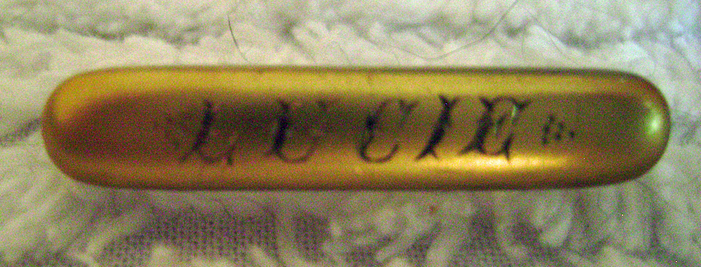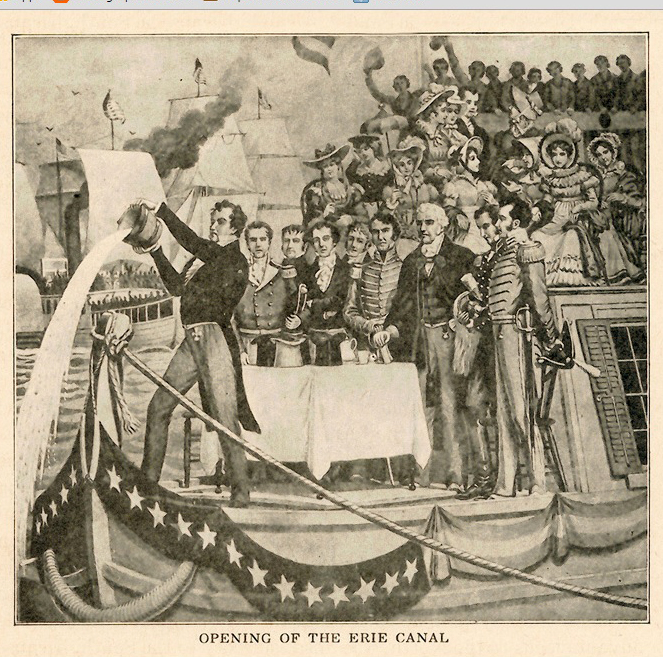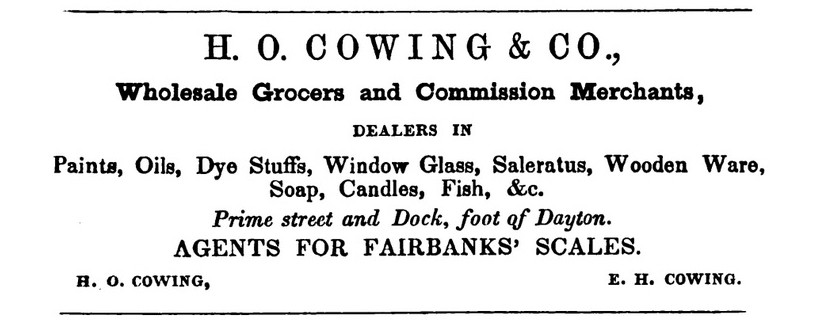Lucie Bagg, half-sister to my three-times great grandfather Stanley Bagg, has represented a brick wall for me ever since I started genealogy. I had never heard of her, or of her two half-sisters, before I started to research the Bagg family. I found a record of her baptism in La Prairie, Lower Canada (now Quebec),1 but that was it.
Gradually, clues emerged. Lucie was mentioned as a beneficiary in the will that her half-sister Sophia Bagg, veuve (widow) Gabriel Roy, wrote in 18562, so I realized she must have lived to adulthood. Then I ran across an 1816 marriage record for Lucy Baggs and William Kaene in Buffalo and Vicinity, Erie County, New York.3 It was easy to imagine that she had moved to Buffalo since her family was originally from the United States. I found the Kaene family on several public members’ trees on Ancestry, but I wanted evidence that the Lucy I had found was the Lucie I was looking for. Finally, I found it: the 1860 U.S. Federal Census listed Lucy Kaene, born Lower Canada.4
Now I can tell her story:
Lucie Bagg was born on 11 Jan. 1798 in La Prairie, Lower Canada to American-born, Protestant parents, but since there was no Protestant church in the town, she was baptized in the local Catholic church. The priest who recorded her baptism was French-speaking and he used the French spelling of Lucy in the register. Lucie lived much of her life in the United States and appears in census records as Lucy, but to her family in Canada, she remained Lucie.

Lucie’s father, innkeeper Phineas Bagg (c. 1750-1823), had moved to La Prairie, on the banks of the St. Lawrence River near Montreal, from Pittsfield, Massachusetts with his four children by his now- deceased first wife and with Lucie’s mother, who was probably Ruth Langworthy.5
He had fallen into debt in Pittsfield and lost his farm to repay his creditors, so he had come to Canada to start a new life.6 La Prairie was then a prosperous town on the route between Montreal and New England, and a number of Americans lived there.
By 1810, Lucie’s half-siblings were beginning to launch their careers and marry. Phineas and son Stanley moved onto the island of Montreal and opened the Mile End Tavern at a crossroads about a mile north of the city.7 The Mile End property was a farm as well as a tavern, and perhaps Lucie helped feed the animals or serve the tavern guests.
In 1816, when she was 18, she married William Kaene, a 19-year-old Pennsylvania-born farmer, somewhere in or near Buffalo. At that time, Buffalo was a village on the eastern shore of Lake Erie. Several years earlier, during the War of 1812, British troops had burned it.

In 1825, the Erie Canal linking Lake Erie with Albany and the Hudson River was completed. Perhaps Lucie attended the canal’s opening ceremonies in Buffalo, the waterway’s western terminus.8 The canal gave a big boost to Buffalo’s economy as the town became a transfer point for both passengers and goods.
In an 1832 city directory, William was listed as “grocer, main Street, dwelling public square”.9 A directory published in 1836 indicated the couple lived a short distance northwest of the town, at the corner of Pennsylvania and Tenth streets, and identified William as a farmer.10
Lucie and William had at least three children: Louise Sophia (1817-1911), Julia Elizabeth (1829-1910) and Ella (1836- ).11 There are big gaps between the girls’ ages, so Lucie may have had other children who died young.12
Julia married John Alexander Brewster in 1858, moved to California and had three children.13 Louise married Harrison Otis Cowing in 1839 and had nine children, two of whom may have died young. 14

Harrison Cowing was a grocer and merchant in Buffalo and became the official head of the household. In 1850, the Cowing family, Lucie and William and their unmarried daughters were living in the brick family home at Pennsylvania and Tenth.15, 16 At that time, William’s occupation was land dealer. He died two years later.17
Lucie was still living with the Cowing family at the time of the 1860 federal census and of the 1865 state census.18 After the Civil War, several of the Cowing children moved to the Midwest, and it appears Lucie joined them. She died in Lafayette, Indiana on February 2, 1874.19
Photo credits:
Private collection
“Opening of the Erie Canal” engraving of a print by Howard Pyle (1853-1911), from The Evolution of New York: by Thomas A. Janvier. www.eriecanal.org, accessed Feb. 28, 2016.
Commercial Advertiser Directory for the City of Buffalo, embellished with a new and correct map. Jewett, Thomas & Co., publishers, 1850. p. 5. babel.hathitrust.org/cgi/pt?id=mdp.39015049262119;view=1up;seq=29
This article is also posted on https://.genealogyensemble.com.
Notes and footnotes:
- “Quebec, Canada, Vital and Church Records (Drouin Collection), 1621-1968” [database on-line]. Ancestry.com, (www.ancestry.ca, accessed 27 Feb. 2016), Gabriel Drouin, comp. Drouin Collection. Montreal, Quebec, Canada: Institut Généalogique Drouin.
- Labadie, Joseph-Augustin, # 14278, 18 Mai 1856. Bibliothèque et Archives nationales du Québec.
- “Early Settlers of New York State, Their Ancestors and Descendants”, extracts from Vol. 2, No. 12 (June 1936) Akron, NY: Thomas Foley. Genealogical Research Library, comp. New York City, Marriages, 1600s-1800s[database on-line] (www.Ancestry.ca, accessed Feb. 27, 2016).
- 1860, Buffalo Ward 10, Erie, New York; Roll: M653_748; Page: 729; Image: 157; Family History Library Film: 803748. Ancestry.com. 1860 United States Federal Census [database on-line]. Provo, UT, USA: Ancestry.com Operations, Inc., 2009. Images reproduced by FamilySearch.
There are two errors in Ancestry.com’s transcription of this census entry: Lucy’s last name was transcribed Kene instead of Kaene, and her age was copied as 68 rather than 62 as the census taker had written it. The original census entry reads, Lucy Kaene, age 62, born Lower Canada. - It is not clear whether Lucie’s mother’s name was Ruth or Lucy. I will write about her soon in another post.
- Janice Hamilton, “An Economic Emigrant”, Writing Up the Ancestors, Oct. 16, 2013, https://www.writinguptheancestors.ca/2013/10/an-economic-emigrant.html
- Janice Hamilton, “The Mile End Tavern,” Writing Up the Ancestors, Oct. 21, 2013, https://www.writinguptheancestors.ca/2013/10/the-mile-end-tavern.html
- The History of Buffalo, New York, Index, http://www.buffaloah.com/h/histindex.htmllinks to a variety of articles and images about individuals, businesses, politicians, the arts, the military and the Erie Canal. Buffalo Research.com, http://www.buffaloresearch.com/onlinedirectories.html, links to online city directories from 1828 to 1941. See also the virtual exhibit focusing on Buffalo in the year 1832: Buffalo and Erie County Historical Society. 175 Years Celebrating the Incorporation of the City of Buffalo. http://www.buffalohistory.org/Explore/Exhibits/virtual_exhibits/buffalo_anniversary/175th/index.htm
- A Directory for the City of Buffalo containing the names and residence of heads of families and householders of the said city on the first of July, 1832. Buffalo: L.P. Chary. p. 84. http://nyheritage.nnyln.net/cdm/pageflip/collection/VHB011/id/5034/type/compoundobject/show/4911/cpdtype/document/pftype/image#page/1/mode/2up
- 1836-1837 Crary’s Buffalo City Directory, p. 94. http://nyheritage.nnyln.net/cdm/pageflip/collection/VHB011/id/8820/type/compoundobject/show/8679/cpdtype/document/pftype/image#page/74/mode/2up
- Ella was born Nov 19, 1836 according to her 1865 christening record: “New York Births and Christenings, 1640-1962,” [database] FamilySearch(https://familysearch.org/ark:/61903/1:1:FDLB-NYM (accessed 27 February 2016), Ella La Fontaine, 19 Nov 1836; citing reference 2:112NCB1; FHL microfilm 1,378,628. Ella was 29 years old in 1865 when she was christened at Grace Episcopal Church, Buffalo. Ella was not listed on the 1850 U.S. Federal Census, but she did appear with the rest of the family on the 1860 U.S. Federal Census and the 1865 State Census. Perhaps she was adopted.
- The 1850 census mentioned a daughter Johanna but I have not found any other mention of her. Also, the transcription of the 1850 census on Ancestry.ca incorrectly lists two other family members, Catherine and Fred. The census gatherer did not write down last names for these people, so they can be mistaken for family, however, Fred was identified as a labourer born in Ireland, while Catherine was born in Germany and may have been a domestic servant.
- “Public Member Trees,” [database] www.Ancestry.ca, Adams Family Tree, Stuart Lauters compiler (accessed 28 Feb. 2016), http://person.ancestry.ca/tree/16093254/person/341207597/facts. This is a well-sourced public member tree on Ancestry.ca for Lucie Bagg and her family.
- “John Cowing Revolutionary War Soldier” provided by Joe W. Cowing, 2002, submitted by Dolores Davidson, www.rootsweb.ancestry.com/~nychauta/Families/Jcowing.htm(accessed 1 March, 2016). Harrison Otis Cowing (1814-1839) is part of generation 7 in this family tree. His son Stanley Bagge Cowing, born 1844, may have been named after Lucie’s brother Stanley Bagg. C
- Commercial Advertiser Directory for the City of Buffalo, embellished with a new and correct map. Jewett, Thomas & Co., publishers, 1850, p. 118. http://babel.hathitrust.org/cgi/pt?id=mdp.39015049262119;view=1up;seq=174
- 1850, Buffalo Ward 5, Erie, New York; Roll: M432_502; p. 491B; Image: 486. Entry for William Kaene; digital image. Ancestry.com (www.ancestry.ca; accessed 28 Feb. 2016), 1850 United States Federal Census [database on-line]. Images reproduced by FamilySearch.
There is a transcription error on Ancestry: the family is indexed as Rane, rather than Kaene. - “Public Member Trees,” [database] www.Ancestry.ca, Adams Family Tree, Stuart Lauters compiler (accessed 28 Feb. 2016), http://person.ancestry.ca/tree/16093254/person/762097336/facts.
- New York, State Census, 1865 [database on-line]. Ancestry.com (www.ancestry.ca, accessed 28 Feb. 2016), Census of the state of New York, for 1865. Microfilm. New York State Archives, Albany, New York. Note the census-taker erroneously spelled the family name Kane.
- “Public Member Trees,” [database] www.Ancestry.ca, Adams Family Tree, Stuart Lauters compiler (accessed 28 Feb. 2016), http://person.ancestry.ca/tree/16093254/person/1077026843/facts.

